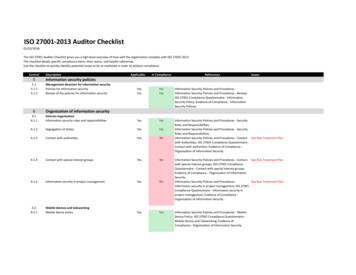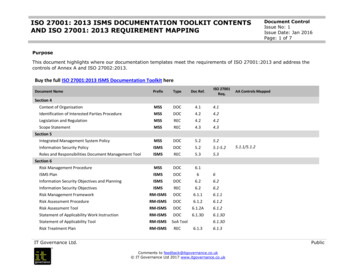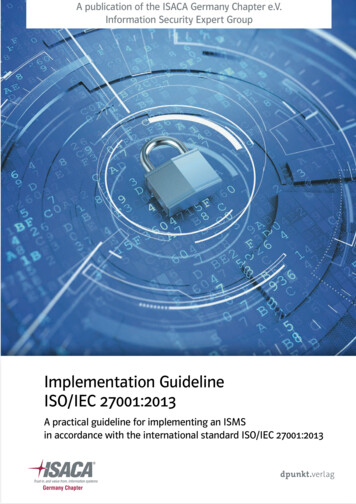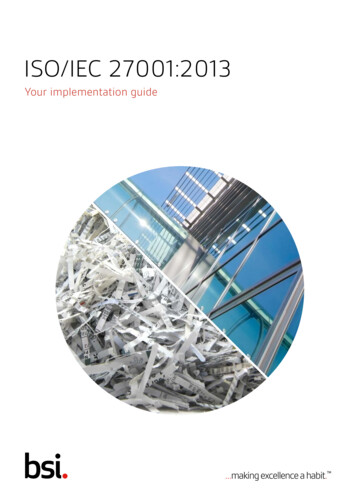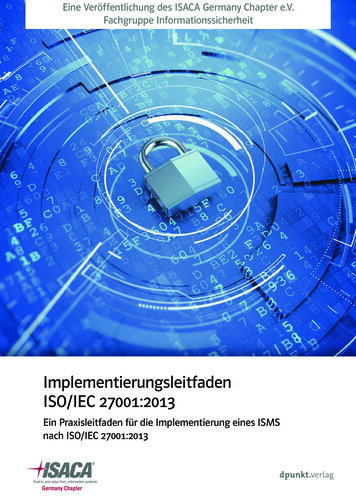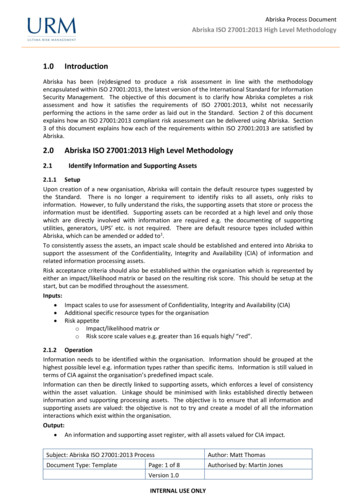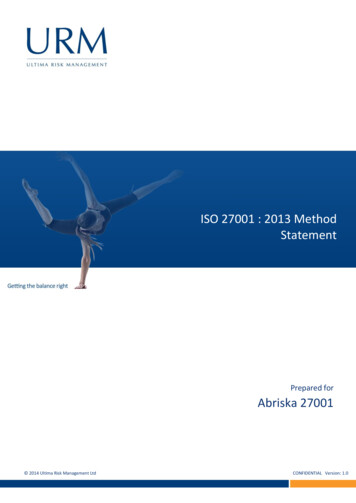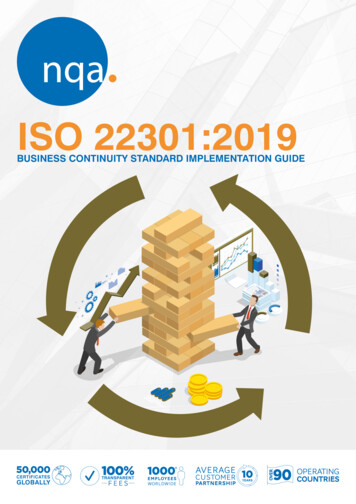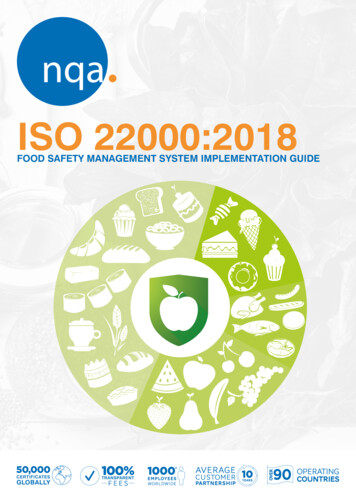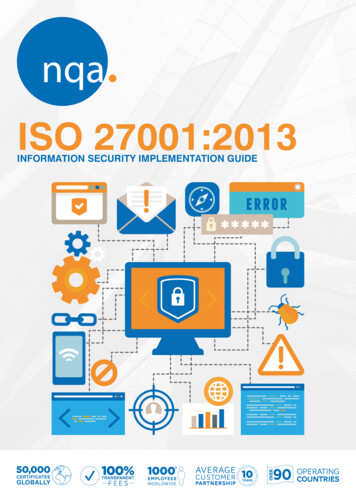
Transcription
ISO 27001:2013INFORMATION SECURITY IMPLEMENTATION GUIDE50,000CERTIFICATESGLOBALLYTRANSPARENT90
ISO 27001:2013IMPLEMENTATION GUIDE2*UK and ISOIreland27001:2013onlyIMPLEMENTATION GUIDE
ContentsIntroduction to the standardP04Benefits of implementationP05Key principles and terminologyP06PDCA cycleP07Risk based thinking / auditsP08Process based thinking / auditP09Annex SLP10CLAUSE 1: ScopeP11CLAUSE 2: Normative referencesP12CLAUSE 3: Terms and definitionsP13CLAUSE 4: Context of the organizationP14CLAUSE 5: LeadershipP16CLAUSE 6: PlanningP18CLAUSE 7: SupportP22CLAUSE 8: OperationP24CLAUSE 9: Performance evaluationP26CLAUSE 10: ImprovementP28Get the most from your managementP30Next steps once implementedP31ISO 27001:2013 IMPLEMENTATION GUIDE3
INTRODUCTIONTO THE STANDARDMost businesses hold or have access to valuable or sensitive information. Failure to provideappropriate protection to such information can have serious operational, financial and legalconsequences. In some instances, these can lead to a total business failure.The challenge that most businesses struggle with is how to provide appropriate protection. In particular, howdo they ensure that they have identified all the risks they are exposed to and how can they manage them in away that is proportionate, sustainable and cost effective?ISO 27001 is the internationally-recognised standard for Information Security Management Systems (ISMS). Itprovides a robust framework to protect information that can be adapted to all types and sizes of organization.Organizations that have significant exposure to information-security related risks are increasingly choosing toimplement an ISMS that complies with ISO 27001.The 27000 FamilyThe 27000 series of standards started life in 1995 as BS7799 and was written by the UK’s Department of Trade andIndustry (DTI). The standards correctly go by the title “ISO/IEC” because they are developed and maintained jointly bytwo international standards bodies: ISO (the InternationalOrganization for Standardization) and the IEC (the InternationalElectrotechnical Commission). However, for simplicity, ineveryday usage the “IEC” part is often dropped.There are currently 45 published standards in the ISO 27000series. Of these, ISO 27001 is the only standard intended forcertification. The other standards all provide guidance on bestpractice implementation. Some provide guidance on how todevelop ISMS for particular industries; others give guidance onhow to implement key information security risk managementprocesses and controls.Regular reviews and updatesISO standards are subject to review every five yearsto assess whether an update is required.The most recent update to the ISO 27001 standard in 2013brought about a significant change through the adoptionof the “Annex SL” structure. While there were some veryminor changes made to the wording in 2017 to clarify therequirement to maintain an information asset inventory,ISO 27001:2013 remains the current standard thatorganizations can achieve certification to.4ISO 27001:201527001:2013 IMPLEMENTATION GUIDEThree of the standards are particularly helpful toall types of organizations when implementing anISMS. These are: ISO 27000 Information Technology – Overviewand vocabulary ISO 27002 Information technology – Securitytechniques – Code of practice for informationsecurity controls. This is the most commonlyreferenced, relating to the design andimplementation of the 114 controls specified inAnnex A of ISO 27001. ISO 27005 Information Technology – Securitytechniques – Information security management.
BENEFITS OFIMPLEMENTATIONInformation security is becoming increasingly important to organizations, and the adoptionof ISO 27001 therefore more and more common. Most organizations now recognise that it isnot a question of if they will be affected by a security breach; it is a question of when.Implementing an ISMS and achieving certification to ISO 27001 is a significant undertaking for most organizations.However, if done effectively, there are significant benefits for those organizations that are reliant on the protection ofvaluable or sensitive information. These benefits typically fall into three areas:COMMERCIALPEACE OF MINDHaving independent third-party endorsementof an ISMS can provide an organization with acompetitive advantage, or enable it to ‘catch up’with its competitors. Customers that are exposedto significant information security risks areincreasingly making certification to ISO 27001a requirement in tender submissions. Wherethe customer is also certified to ISO 27001they will, in the medium term, choose to workonly with suppliers whose information securitycontrols they have confidence in and that havethe capability to comply with their contractualrequirements.Many organizations have information thatis mission-critical to their operations, vitalto sustaining their competitive advantageor an inherent part of their financial value.Having a robust and effective ISMS in placeenables business owners and managers withresponsibility for managing risks to sleep easierat night knowing that they are not exposed to arisk of heavy fines, major business disruption ora significant hit to their reputation.For organizations that want to work with thistype of customer, having an ISO 27001 certifiedISMS is a key requirement for sustaining andincreasing their commercial revenues.In today’s knowledge-based economy, almostall organizations are reliant on the security of keyinformation. Implementation of a formal ISMS isa proven method of providing such security.ISO 27001 is an internationally recognisedframework for a best practice ISMS andcompliance with it can be independently verifiedto both enhance an organization’s image andgive confidence to its customers.OPERATIONALThe holistic approach of ISO 27001 supportsthe development of an internal culture that isalert to information security risks and has aconsistent approach to dealing with them. Thisconsistency of approach leads to controls thatare more robust in dealing with threats. Thecost of implementing and maintaining them isalso minimised, and in the event of them failingthe consequences will be minimised and moreeffectively mitigated.ISO 27001:2013 IMPLEMENTATION GUIDE5
KEY PRINCIPLESAND TERMINOLOGYThe core purpose of an ISMS is to provide protection for sensitive or valuable information.Sensitive information typically includes information about employees, customers and suppliers.Valuable information may include intellectual property, financial data, legal records, commercialdata and operational data.THE TYPES OFRISKS THATSENSITIVEThetypes of nINFORMATIONare subject toAREgenerallySUBJECTcanbeTOCAN GENERALLYgroupedinto threecategories:BE GROUPEDINTO tywhere one ormore persons gainunauthorised accessto information.where the content of theinformation is changedso that it is no longeraccurate or complete.where access to theinformation is lostor hampered.These information security risk types are commonly referred toas “CIA”.Risks in information security typically arise due to thepresence of threats and vulnerabilities to assets thatprocess, store, hold, protect or control access to informationwhich gives rise to incidents.Assets in this context are typically people, equipment, systemsor infrastructure.Information is the data set(s) that an organization wants toprotect such as employee records, customer records, financialrecords, design data, test data etc.Incidents are unwanted events that result in a loss ofconfidentiality (e.g. a data breach), integrity (e.g. corruptionof data) or availability (e.g. system failure).Threats are what cause incidents to occur and may bemalicious (e.g. a burglar), accidental (e.g. a key stroke error) oran act of God (e.g. a flood).6ISO 27001:2013 IMPLEMENTATION GUIDEVulnerabilities such as open office windows, source codeerrors, or the location of buildings next to rivers, increasethe likelihood that the presence of a threat will result in anunwanted and costly incident.In information security, risk is managed through the design,implementation and maintenance of controls such as lockedwindows, software testing or the siting of vulnerable equipmentabove ground floor levels.An ISMS that complies with ISO 27001 has an interrelatedset of best practice processes that facilitate and support theappropriate design, implementation and maintenance ofcontrols. The processes that form part of an ISMS are usuallya combination of existing core business processes (e.g.recruitment, induction, training, purchasing, product design,equipment maintenance, service delivery) and those specificto maintaining and improving information security (e.g. changemanagement, information back-up, access control, incidentmanagement, information classification).
PDCA CYCLEISO 27001 is based on the Plan-Do-Check-Act (PDCA) cycle, also known as the Demingwheel or Shewhart cycle. The PDCA cycle can be applied not only to the managementsystem as a whole, but also to each individual element to provide an ongoing focus oncontinuous improvement.In brief:Plan:Do:Check:Act:Establish objectives,resources required,customer andstakeholderrequirements,organizational policiesand identify risks andopportunities.Implement whatwas planned.Monitor and measureprocesses to establishperformance againstpolicies, objectives,requirements andplanned activities andreport the results.Take action to improveperformance, asnecessary.PDCA model ISO 27001INFORMATION SECURITY MANAGEMENT SYSTEM (4)ESTABLISHISMSINTERESTEDPARTIESPlanDoMAINTAINAND IMPROVETHE INTERESTEDPARTIESIMPLEMENTAND OPERATETHE ISMSActCheckMONITORAND REVIEWTHE ISMSMANAGEDINFORMATIONSECURITYPlan-Do-Check-Act is an example of a closed-loop system. This ensures the learning from the ‘do’ and ‘check’ stages areused to inform the ‘act’ and subsequent ‘plan’ stages. In theory this is cyclical, however it’s more of an upward spiral as thelearning moves you on each time you go through the process.ISO 27001:2013 IMPLEMENTATION GUIDE7
RISK BASEDTHINKING/AUDITSAudits are a systematic, evidence-based, process approach to evaluation of yourInformation Security Management System. They are undertaken internally and externallyto verify the effectiveness of the ISMS. Audits are a brilliant example of how risk-basedthinking is adopted within Information Security Management.1st Party Audits– Internal AuditsInternal audits are a great opportunity for learning withinyour organization. They provide time to focus on a particularprocess or department in order to truly assess its performance.The purpose of an internal audit is to ensure adherence topolicies, procedures and processes as determined by you, theorganization, and to confirm compliance with the requirementsof ISO 27001.Second party audits are usually carried out by customers orby others on their behalf, or you may carry them out on yourexternal providers. 2nd party audits can also be carried out byregulators or any other external party that has a formal interestin an organization.You may have little control over the timing and frequency ofthese audits, however establishing your own ISMS will ensureyou are well prepared for their arrival.Audit Planning3rd Party – Certification AuditsDevising an audit schedule can sound like a complicatedexercise. Depending on the scale and complexity of youroperations, you may schedule internal audits anywhere fromevery month to once a year. There’s more detail on this insection 9 – performance evaluation.Third party audits are carried out by external bodies, usuallyUKAS accredited certification bodies such as NQA.Risk-based ThinkingThe best way to consider frequency of audits is to look at therisks involved in the process or business area to be audited.Any process which is high risk, either because it has a highpotential to go wrong or because the consequences would besevere if it did go wrong, should be audited more frequentlythan a low risk process.How you assess risk is entirely up to you. ISO 27001 doesn’tdictate any particular method of risk assessment or riskmanagement.82nd Party – External AuditsISO 27001:2013 IMPLEMENTATION GUIDEThe certification body will assess conformance to theISO 27001:2013 standard. This involves a representative of thecertification body visiting the organization and assessing therelevant system and its processes. Maintaining certificationalso involves periodic reassessments.Certification demonstrates to customers that you have acommitment to quality.CERTIFICATION ASSURES: regular assessment to continually monitorand improve processes. credibility that the system can achieveits intended outcomes. reduced risk and uncertainty and increasemarket opportunities. consistency in the outputs designed to meetstakeholder expectations.
PROCESS BASEDTHINKING/AUDITA process is the transformation of inputs to outputs, which takes place as a series ofsteps or activities which result in the planned objective(s). Often the output of one processbecomes an input to another subsequent process. Very few processes operate in isolationfrom any other.“Process: set of interrelated or interactingactivities that use inputs to deliver anintended result.”ISO 27001:2013 Fundamentals and VocabularyEven an audit has a process approach. It begins withidentifying the scope and criteria, establishes a clear courseof action to achieve the outcome and has a defined output(the audit report). Using the process approach to auditing alsoensures the correct time and skills are allocated to the audit.This makes it an effective evaluation of the performance of theISMS.“Consistent and predictable results are achieved moreeffectively and efficiently when activities are understood andmanaged as interrelated processes that function as acoherent system.”ISO 27001:2013 Fundamentalsand VocabularyUnderstanding
ISO 27001 is an internationally recognised framework for a best practice ISMS and compliance with it can be independently verified to both enhance an organization’s image and give confidence to its customers. Information security is becoming increasingly important to organizations, and the adoption of ISO 27001 therefore more and more common. Most organizations now recognise that it isFile Size: 2MBPage Count: 32

